UNCROWDEDR
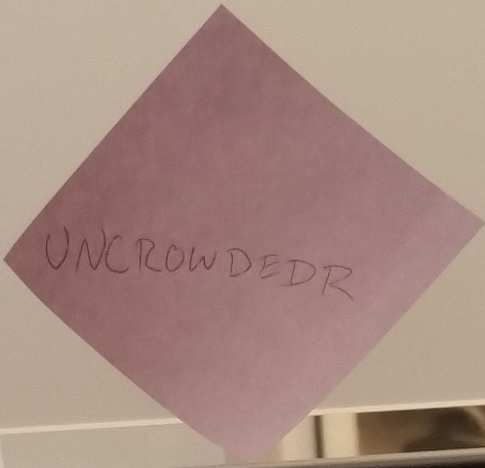
For a few years now, there has been a sticky note at our desk that says “UNCROWDEDR” to remind us (DSN and Jake Hofman) to build an app that tells us when other people are doing things (like going to the movies or coffee shops or grocery stores) so that we can do these things when nobody else is doing them. We liked to call this idea:
- Uncrowdedr
- The anti-social app
- The app that gets less useful as more people use it
- The Andy Warhol
The last one comes from something Jeff Nickerson told us about Mr. Warhol, who apparently liked to do certain things at the least popular times, such as going to movies on Monday. (If anyone knows the reference, let us know).
Good news. Now we don’t have to build it, as our friends at Google have built it into location search results on Android phones.
See the TIME magazine article Google Fixed the Worst Part About Grocery Shopping.
Here’s a screenshot. To see for yourself, search for “blue bottle williamsburg” from the Google search bar in Android (it doesn’t seem to be in map result data yet).
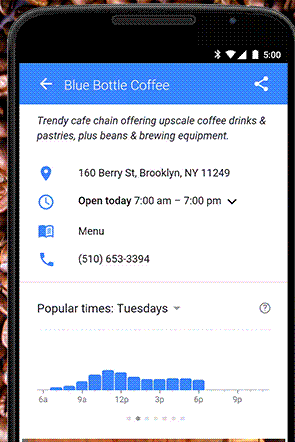
What’s cooler is that data quality/production work on this product was done by one Quang Duong, who was an intern when we were all at Yahoo Research.
Filed in
Gossip ,
Ideas
 Subscribe
Subscribe to Decision Science News by Email (one email per week, easy unsubscribe)
AN ESTIMATE

We travel a lot, rent a lot of cars, drive around in far flung corners of the USA, and correspondingly, hear a lot of country music.
One song we’ve heard quite a few times goes:
I dug my key into the side
Of his pretty little souped-up 4 wheel drive,
Carved my name into his leather seats.
I took a Louisville slugger to both headlights,
Slashed a hole in all four tires.
Maybe next time he’ll think before he cheats.
It’s a Carrie Underwood song called “Before He Cheats” and is also featured in the movie Pitch Perfect 2.
Anyway, the last time we heard this song, we couldn’t help but think, “Darn, that’s a lot of damage she does to his truck. But how much?”
Then we thought, “Estimation is a vital skill in decision science. We should really estimate this.”
Then we thought, “blog post.”
Let’s break it down
Lyric: “I dug my key into the side of his pretty little souped-up 4 wheel drive”
Corresponding repair: Fixed a “keyed” truck door
Estimate: $650
Lyric: “Carved my name into his leather seats”
Corresponding repair: Two front seats professionally reupholstered
Estimate: $750
Lyric: “I took a Louisville slugger to both headlights”
Corresponding repair: Replacing two headlight assemblies
Cost: $950
Lyric: “Slashed a hole in all four tires”
Corresponding repair: Replacing four truck tires
Cost: $800
What’s the total damage? $3,150.
Is that a big crime? Is is! It’s a felony offense with a potentially lengthy prison sentence in Carrie Underwood’s native Oklahoma.
So, when you hear that song, maybe imagine it’s being sung from prison.
(Yes, we’re assuming she got caught, but come on, she carved her name into the leather seats).
Filed in
Ideas
 Subscribe
Subscribe to Decision Science News by Email (one email per week, easy unsubscribe)
A PACKING LIST AND MORE

Esquire recently posted some of Anthony Bourdain’s travel tips. Some good stuff there. Seeing the list reminded the editorial team at Decision Science News that we’ve always wanted to do a post on this. We travel a lot.
A PACKING LIST SAVES US TIME AND PREVENTS ERRORS
This packing list is based on one that David Allen (of Getting Things Done fame) shared. We’ve modified it to suit our needs. We pack from a list every trip. It gets packing time down to 20 minutes and zero errors. Here is the PDF (source for editing), ready to print four-per-page.
=ESSENTIALS
Socks
Underwear
T-shirts short + long sleeve
Shirts
Pants
Shoes
Belt
Glasses + contacts
Razor + cord
=FITNESS
Sneakers
Exercise clothes
Bathing suit
=BUSINESS ONLY
Dress shirts
Dress pants
Suit or jacket
Tie
Cufflinks #so easy to forget
=WEATHER DEPENDING
Sunglasses
Sandals
Shorts
Sunscreen
Umbrella
Gloves
Coat
Sweater
=IN WALLET
Business cards
Airport lounge ID card
=IN WALLET-INTERNATIONAL
Foreign credit cards
Foreign transit cards (UK: Oyster; NL: OV Chip)
=IN CARRY ON
Toiletries ziploc
Phone + headphones w/ microphone
Hoodie #avoid freezing on the plane
Inflatable Neck pillow #see below
Laptop + charger
USB wall plug adapter
Retractable micro USB cord #see below
Plane/train/car/hotel info
Maps (cached to phone) + directions
USB memory sticks
Conference programme
Prescription medicine
=IN CARRY ON-INTERNATIONAL
Passport
Foreign currency
Foreign plug adapters #see below
=DO BEFORE LEAVING
Weather checked?
Computer synced?
Presentation to USB and emailed to self?
Withdrew cash?
Checked in + chosen seats?
GETTING A PHONE WITH FREE GLOBAL DATA WAS GAME CHANGING
Since we moved from Verizon to t-mobile, our phone now works everywhere in the world and gets free data everywhere in the world. Much better than schlepping around a second unlocked phone and switching sim cards.
INFLATABLE NECK PILLOWS MAKE US FEEL GOOD
For a long time, we looked at those silly looking people with their neck pillows and felt superior. Then we tried one. They really make you feel better. We’ve tried four kinds, including some expensive ones, but our favorite is the Samsonite Inflatable Neck Pillow. It folds up to an impossibly small size and disappears so you won’t look a doofus marching around the airport with one tied to your bag.
IT’S NOT THE JET LAG, IT’S THE SLEEP DEPRIVATION
More information.
BOARDING TIME CAN BE UP TO 10 MINUTES BEFORE THE PUBLISHED BOARDING TIME
This matters if you have status with the airline and get to board first. If you show up at the time on the ticket, you may be boarding with group 4.
WE PREVENT LIQUIDS FROM LEAKING THIS WAY
Two things. 1) Squeeze a little air out 2) Put a little square of plastic wrap over the mouth of the bottle. Screw the cap on. Voila.
WE LIKE RETRACTABLE USB CORDS
Like these. Keeps things tidy and untangled. Apologize to the squirrels who were nesting in your bag.
WE LIKE INTERNATIONAL PLUG ADAPTERS WITH BUILT-IN USB PORTS
Like these. Use your computer and charge your phone at the same time. Amaze your friends with what you can charge in one outlet, anywhere in the world.
WE LIKE COMPRESSION BAGS
Like these. They make your stuff, especially winter stuff, take up less space. And they act as laundry bags for the return trip. And they will keep a wet bathing suit from getting the rest of your stuff wet. And you don’t need a vacuum cleaner to use them. Just seal and roll. The air escapes through magical one-way valves. Not recommended for things that wrinkle easily. BTW, dry cleaning bags do a pretty good job of keeping things wrinkle free.
MEMORIZING OUR PASSPORT NUMBER WAS WORTH IT
If you travel internationally a lot, this is more useful than it sounds. You get asked for it surprisingly often, and you never feel like digging up your passport when filling out forms. We even have advice on how to remember long numbers. Lock it in once and you’re good for life.
SWIM DON’T RUN
And avoid packing an extra pair of shoes for exercise. We read about this in an interview once.
WE TRY NOT TO BOOK FLIGHTS THAT DEPART BETWEEN 11AM and 10PM
This helps us avoid flight delays.
WE ALWAYS RETURN HOME WITH ZERO FOREIGN COINS
And this is how we do it.
If you have tips, feel free to share them in the comments.
Photo credit: http://www.flickr.com/photos/araswami/1948449158/
Filed in
Jobs ,
R
 Subscribe
Subscribe to Decision Science News by Email (one email per week, easy unsubscribe)
CHICAGO BASED POSITION

The Group: On the Behavioral Insights Team, we use behavioral science to help people engage with and improve their finances. We then run rapid, digital experimental studies to determine what works, and what doesn’t, and publicize the results.
The Role: Help millions of people retire with dignity and in comfort. Morningstar is looking for an applied behavioral scientist, to help understand and overcome the behavioral obstacles that individuals face to financing their retirement. You’ll pursue original research alongside a team of like-minded behavioralists and leading academics from around the country. This position is based in our Chicago office.
Responsibilities
• Lead our retirement-focused initiatives, developing our strategy to better understand and to apply lessons about financial decision-making behavior.
• Design, execute, and analyze large-scale randomized control trials (Morningstar interacts with millions of individual investors, their advisors, and their employers).
• Work with the marketing, product, and research teams to identify their pressing questions around retirement behavior and assist them in designing and running experimental studies.
• Coordinate with our Behavioral Science Advisory Board – amazing and thoughtful researchers from around the country – to develop new interventions, and measure their real-life impact.
• Publicize your findings in the media, papers, and at conferences.
Requirements
• Postgraduate training in behavioral social science, especially on financial decision making, or equivalent professional experience required.
• Professional experience in applying behavioral interventions specifically to improving retirement outcomes is ideal.
• Demonstrated ability writing about behavioral research for a general audience.
• Experience with digital communications (marketing, software products), and A/B testing tools for them, is a big plus.
• At least two years of experience using R or STATA to analyze complex datasets and panel data (academics: yes, GRAs count).
• Experience doing data processing and analysis in SQL is also a plus.
In your cover letter, mention how you’d approach the issue of helping people prepare for retirement.
Morningstar is an equal opportunity employer.
See: https://www.linkedin.com/jobs2/view/56477808?trk=job_view_browse_map&trk=job_view_browse_map
Filed in
Ideas ,
R
 Subscribe
Subscribe to Decision Science News by Email (one email per week, easy unsubscribe)
A DOZEN YEARS OF ESCAPE DATA FROM NEW YORK STATE

Click to enlarge
The recent prison break in upstate New York got us wondering how long prison escapes tend to last. We found some data on prison escapes in New York State. See the dot plot above.
We then found a table in the Atlantic, which cites this paper, on perhaps more skillful inmates who managed to stay on the run a bit longer, though 80% of them were back in prison inside a week.
The upshot from both analyses is the same: if you escape from prison, you’re probably going to be re-captured within a day.
R CODE
Filed in
Ideas ,
R
 Subscribe
Subscribe to Decision Science News by Email (one email per week, easy unsubscribe)
CORRELATION WITH REPUBLICAN VOTING IN THE 2012 PRESIDENTIAL ELECTION

Click to see a larger, stripped down version
In light of the good news today that the Supreme Court ruled that same-sex couples have the right to marry in the United States, we thought we’d look at when same-sex marriage laws became effective by state (if they did at all) before today.
Noting that same sex marriage is a dividing issue between the left and right in the US, we thought we’d compare the date of when same-sex marriage laws become effective in each state with each state’s Republican (two-party) vote share in 2012. Results are below.
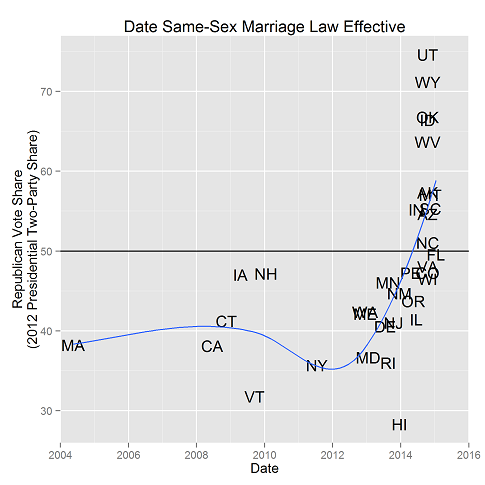
Click to enlarge
Note that California’s same-sex marriage law was effective in 2008, then it was overturned, and then made effective again in 2013. We went with the earlier date because you’ve got to chose something.
The next question is “what about the states that were added by the Supreme Court decision today”? We made a second plot, below, in which we put today’s date for those states in the “effective date” column. The result is pretty much the same. See at the top of the post the ribbom plot contributed by David Lallemant in the comments.
It is interesting to note that none of the plurality Romney-voting states had same sex marriage laws in effect before 2014.
A couple last things. You probably want to see the data, because the graph can be hard to read.
THE DATA
Or you can get the data and the R code both
R CODE
ABSTRACT SUBMISSION DEADLINE FOR SJDM JUNE 20, 2015

Just a reminder that the Society for Judgment and Decision Making Conference deadline is tomorrow, June 20, 2015.
It’s easy to submit (you only need a 600 word abstract), though tough to get in (historically about 25% of submissions are accepted).
Send your best decision-making work to:
http://www.sjdm.org/programs/2015-cfp.html
Find out more about the conference here.
Filed in
SJDM
 Subscribe
Subscribe to Decision Science News by Email (one email per week, easy unsubscribe)
SOCIETY FOR JUDGMENT AND DECISION MAKING NEWSLETTER

The quarterly Society for Judgment and Decision Making newsletter can be downloaded from the SJDM site:
http://sjdm.org/newsletters/
It features jobs, conferences, announcements, and more.
Enjoy!
Decision Science News / SJDM Newsletter Editor
CREATE: CROWDSOURCING EVIDENCE, ARGUMENTATION, THINKING AND EVALUATION

The Intelligence Advanced Research Projects Activity (IARPA) will host a Proposers’ Day Conference for the Crowdsourcing Evidence, Argumentation, Thinking and Evaluation (CREATE) Program on June 30, 2015, in anticipation of the release of a new solicitation in support of the Program. The Conference will be held from 9:00 AM to 4:00 PM EDT in the Washington, DC metropolitan area. The purpose of the Conference will be to provide introductory information on CREATE and the research problems that the Program aims to address, to respond to questions from potential proposers, and to provide a forum for potential proposers to present their capabilities and identify potential team partners. This announcement serves as a pre-solicitation notice and is issued solely for information and planning purposes. The Proposers’ Day Conference does not constitute a formal solicitation for proposals or proposal abstracts. Conference attendance is voluntary and is not required to propose to future solicitations (if any) associated with this Program. IARPA will not provide reimbursement for any costs incurred to participate in this Proposers’ Day.
BACKGROUND AND PROGRAM GOALS
CREATE aims to improve analytic thinking by combining structured reasoning techniques with crowdsourcing. CREATE will develop and test methods to help dispersed groups of individuals identify and evaluate the structure and content of arguments in relation to alternative hypotheses. Intelligence analysts, along with professionals in other fields, assess competing hypotheses in light of multiple considerations, including reasons, evidence and assumptions. Reasons and evidence often differ in credibility and diagnosticity. CREATE will develop (1) structured methods to elicit and aggregate the elements of an argument and (2) ways to crowdsource the use of these methods, so that many individuals can collectively develop and refine an argument. The methods will be capable of treating reasoning involving quantitative and qualitative information. The CREATE Program expects to draw upon the strengths of academia and industry through collaborative teaming. It is anticipated that teams will be multidisciplinary and might include social and behavioral scientists, experts in informal logic, and computer scientists.
REGISTRATION INFORMATION
Attendees must register no later than 6:00 pm EDT, June 23, 2015 at
https://events.signup4.com/CREATEPDRegistration_June2015.
Directions to the Conference facility and other materials will be provided upon registration. No walk-in registrations will be allowed.
Due to space limitations, attendance will be limited to the first 250 registrants. If there are more registrants than available seats, priority will be given to the first two registrants from each organization. All attendees will be required to present government-issued photo identification to enter the event. Non-U.S. citizens will be required to present passports.
ADDITIONAL INFORMATION
The afternoon will include unclassified presentations and poster sessions to provide an opportunity for attendees to present their organizations’ capabilities and to explore teaming arrangements. Attendees who wish to present organization capabilities for teaming opportunities may submit a request through the registration website. Details on the presentation and poster formats, and the procedure for submitting a request to present, will be provided after approval to register for the Conference has been granted. Time available for presentations and posters will be limited. Therefore, presentations will be limited to the first 15 registered respondents who request an oral presentation, and posters will be limited to the first 15 registered respondents who request a poster presentation. These presentations are not intended to solicit feedback from the Government, and Government personnel will not be present during the presentations.
This Proposers’ Day is intended for participants who are eligible to compete on the anticipated BAA. Other Government Agencies, Federally Funded Research and Development Centers (FFRDCs), University Affiliated Research Centers (UARCs), or any other similar organizations that have a special relationship with the Government, that gives them access to privileged or proprietary information, or access to Government equipment or real property, will not be eligible to submit proposals to the anticipated BAA nor participate as team members under proposals submitted by eligible entities. While such entities are not prohibited from attending the Proposers’ Day, due to space limitations, preference will be given first to those organizations that are eligible to compete. Questions concerning Conference and registration can be sent to dni-iarpa-events@iarpa.gov.
Questions regarding the program can be sent to dni-iarpa-baa-15-11@iarpa.gov.
Contracting Office Address:
Office of the Director of National Intelligence
Intelligence Advanced Research Projects Activity
Washington, DC 20511
Primary Point of Contact:
Steven Rieber
Program Manager, IARPA
dni-iarpa-baa-15-11@iarpa.gov
Solicitation Number:
IARPA-BAA-15-11
Link at FedBizOpps.Gov
Link at IARPA.gov
Filed in
Ideas ,
R
 Subscribe
Subscribe to Decision Science News by Email (one email per week, easy unsubscribe)
INCOME PERCENTILES AND INCOMES PAINT DIFFERENT PICTURES
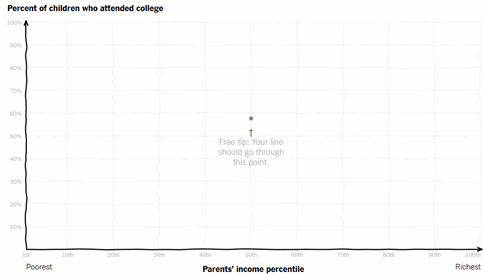
The amazing team at the New York Times have a “You Draw It” feature in The Upshot in which readers try their hands at drawing a graph. The graph should show the probability of a child going to college based on their parents’ percentile in the income distribution.
As a cool added feature, after people took their guesses, they could see, in shades of red, the other guesses people had taken and compare it to the actual graph.
SPOILER ALERT: You can see the true answer at the bottom of this post. If you want to try your hand at guessing, click through to the NY Times and guess before proceeding.
One way to interpret this relationship is that for every percentile increase in parental income, the probability of college enrollment increases by a constant amount, which might seem somewhat surprising. Even the NY Times editors were surprised by this linear relationship, and the data they collected showed that other people were, too.
Jake Hofman and I wondered “what if people didn’t take the X-axis literally, what if they thought about it as something like log income or income (instead of percentile in the income distribution)?” Percentiles are tricky. They’re buckets with equal numbers of people, but those people can have very different incomes. What would the graph look like if the X-axis were income? Would this relationship be more intuitive to readers?
Jake scraped some income percentile data from whatsmypercent.com and we eyeballed the probability data from the chart at the NY Times. This enabled us to look at the probability of going to college based on income, which tells somewhat of a different story. In these plots, the size of the each point corresponds to the number of people in it.
The change you get by adding $10,000 a family’s income matters considerably for those earning between $10,000 and $100,000 (which the vast majority of Americans do), and matters much less outside that range. At the same time, it’s considerably more difficult for lower income parents to increase their income by this amount.
Probability of going to college vs log income:
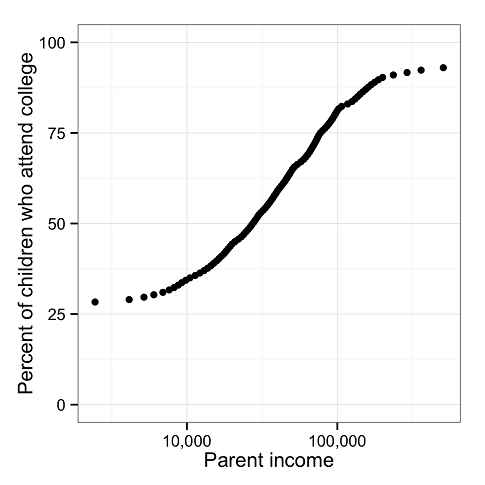
Probability of going to college vs income:
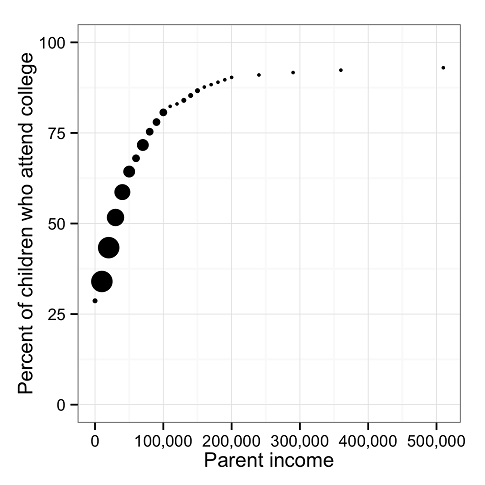
SPOILER ALERT – BELOW YOU WILL SEE THE ANSWER FROM THE NY TIMES
Probability of going to college vs income percentile:
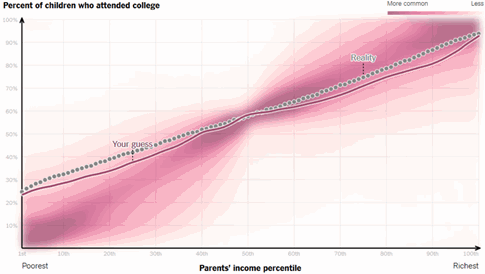
R CODE FOR YOUR CODING PLEASURE
 Subscribe to Decision Science News by Email (one email per week, easy unsubscribe)
Subscribe to Decision Science News by Email (one email per week, easy unsubscribe)
















